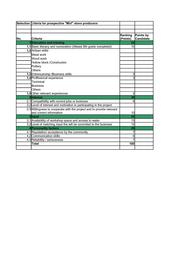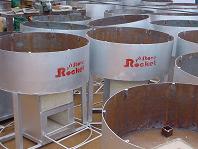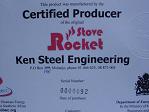Knowledge fuels change - Support energypedia!
For over 10 years, energypedia has been connecting energy experts around the world — helping them share knowledge, learn from each other, and accelerate the global energy transition.
Today, we ask for your support to keep this platform free and accessible to all.
Even a small contribution makes a big difference! If just 10–20% of our 60,000+ monthly visitors donated the equivalent of a cup of coffee — €5 — Energypedia would be fully funded for a whole year.
Is the knowledge you’ve gained through Energypedia this year worth €5 or more?
Your donation keeps the platform running, helps us create new knowledge products, and contributes directly to achieving SDG 7.
Thank you for your support, your donation, big or small, truly matters!
Improved Cookstoves - Production Systems and Quality Management
Cooking Energy System | Basics | Policy Advice | Planning | Designing and Implementing ICS Supply | Designing and Implementing Woodfuel Supply | Climate Change | Extra
Overview
There are three main production systems for stoves:
- Decentralized, individual construction of fixed stoves on site
- Centralized mass production (or small-scale community production) of portable stoves and/or stove liners in a workshop
- Industrial production
A wide spectrum of manufacturing methods falls between these two systems; for example, village stove builders may use prefabricated parts for their locally made mud stoves. The one extreme is the user who builds his own stove directly in his house from locally available material. The other extreme is the centralised production of stoves.
The first system is mostly used in rural areas by informal sector entrepreneurs, whereas the second system is often associated with urban settlements and the formal sector. Each of these approaches to production requires a project to be run in a way that optimises the number and quality of stoves that are made. It will require appropriate training methods and quality control systems. The third system is based on large scale production facilities in the formal sector.
Decentralized Stove Production Systems
A good example of the development of a decentralized production system is the mud rocket stove for rural households in Uganda and Kenya.
| The two-pot mud rocket Lorena stove This is a massive stove that cannot be transported (see stove fact sheet on the right). It is built with locally available material directly on site. The characteristic of this system is:
|
Rocket Lorena Uganda Stove - Factsheet
|
Because the stove has a limited life and the stove builder has to visit the house several times:
- There are many stove builders, mostly living locally. They all have to be trained and their skills and training have to be documented.
- A monitoring system has to be set up to assure high stove quality not only when the stove is installed, but also during its lifetime (or at least during the first months of its use).
- Users have to be involved in the stove installation and monitoring system, as they will be required to conduct periodic maintenance.
In Uganda and Kenya a quality and monitoring system was setup with the following components:
- Certification of quality stove builders: after training and independent construction of 10 stoves, a builder is qualified as a ‘commercial stove builder’ and receives a badge.
- Monitoring personnel are selected and have the following tasks:
| - To monitor the quality of the stoves by unannounced household visits using a checklist: | Kenya Rocket Mud Stove Checklist for Monitors |
| - To monitor regularly the number of stoves constructed and used | |
| - To ensure that each home equipped with a new stove has received the user guidelines and knows how to maintain the stove. |
| The Pyramid Strategy – a training method for capacity development of stove producers in Kenya (2007) Source: PSDA, Kenya | Pyramid Training |
| Uganda: CONSTRUCTION MANUAL FOR HOUSEHOLD ROCKET STOVES for use as a training tool for stove artisans
|
|
|
Versión français: Guide français de foyer rocket en banco Uganda, 2008 MANUEL DE CONSTRUCTION DES FOYERS AMÉLIORÉS EN BANCO POUR LES MÉNAGES |
Guide Français de foyer rocket en banco Uganda
|
| Another example is the Inkawasi stove, produced in Peru: Manual de Capacitación e Instalación de Cocinas Mejoradas |
Inkawasi Stove Peru - Stove Factsheet |
| MANUAL PARA LA CONSTRUCCIÓN DE COCINAS MEJORADAS MALENA, Bolivia 2009 |
Malena Manual - Bolivia |
Centralised Stove Production Systems
Portable stoves, made of metal or ceramic, are generally produced in workshops or factories and then sold directly to the end users either directly from the factory, via wholesalers and retailers, or through distribution organisations. Generally, this results in a small number of producers. In this case a quality management system has to focus on:
- the skills and potential of the producers
- the stove itself
Quality Management
At the producer level, this includes selecting the right producers and ensuring that they are suitably qualified. Projects supported by GTZ have developed several methods to select the most appropriate producers using the following criteria:
- Education and skills including basic literacy, artisan skills, entrepreneurship and professional experience.
- Their level of interest and the compatibility of stove production with their current employment.
- The availability of workshop space and access to basic commodities.
- Personal factors, such as reputation, communication skills and reliability.
After being selected, producers have to be given the support they need to produce the newly introduced technology through:
- Training in special technical skills, entrepreneurship, quality management
- Financial support; for example, a loan, credit, or a grant
- Starter packages with moulds, tools, manuals, tables of measures
Once the producers have been selected, and have been provided with skills through workshop training schemes, a quality control system should be established, as shown in the table below.
Components of a Good Quality Control System
| Testing and certification of design models or prototypes | The GTZ projects in the Peruvian and Bolivian Andes, for example, contracted the Aprovecho Institute to get Benchmark Certification for all the stoves used in the project [see certification sheets]. After approval of the design model it has to be assured that all stoves produced later have the same quality as the prototypes. |
| External control of the stove quality and the production organisation. |
In some cases this is only done during the initial introductory phase by the project. To maintain a high quality over a long time it is recommended that a constant quality control system is set up. In Burkina Faso, every month an inspector visits the producers and checks the stoves. In Malawi, stoves are regularly checked by the project or by the Department of Energy. If the producer maintains a high quality for a long period of time, only random samples are checked |
| Giving the stove a brand name | The Malawian stoves logo indicates by flames and an L-shaped letter that the stove is built to a rocket stove principle. |
| Branding stoves through distinctive logos (Malawi, Mali, Burkina Faso; Source: GTZ) | |
| Identification of every stove with serial number | In Malawi, each stove leaves the production site with a serial number and a certificate that serves as warranty (granted by producer) |
| Certification of producers and serial numbers of stoves in Malawi (Photos: GTZ) | |
| Systematic registration of the stoves by the producer, when sold to whom | These records are important to document the project’s impact. And they help the stove producer - even if they initially refuse to keep records. They get a better overview about the market and can adjust the number of certificate plates or labels to the real number of produced stoves. A record booklet can be used by illiterate people as shown in the example from Burkina Faso (see picture below). |
Although monitoring and control of these ‘over the counter’ technologies at the workshop gate is easy to operate, it is very difficult and laborious to assess the later use, performance and lifetime of the products in the end users household.
Further Information
References
This article was originally published by GIZ HERA. It is basically based on experiences, lessons learned and information gathered by GIZ cook stove projects. You can find more information about the authors and experts of the original “Cooking Energy Compendium” in the Imprint - GIZ HERA Cooking Energy Compendium.
























